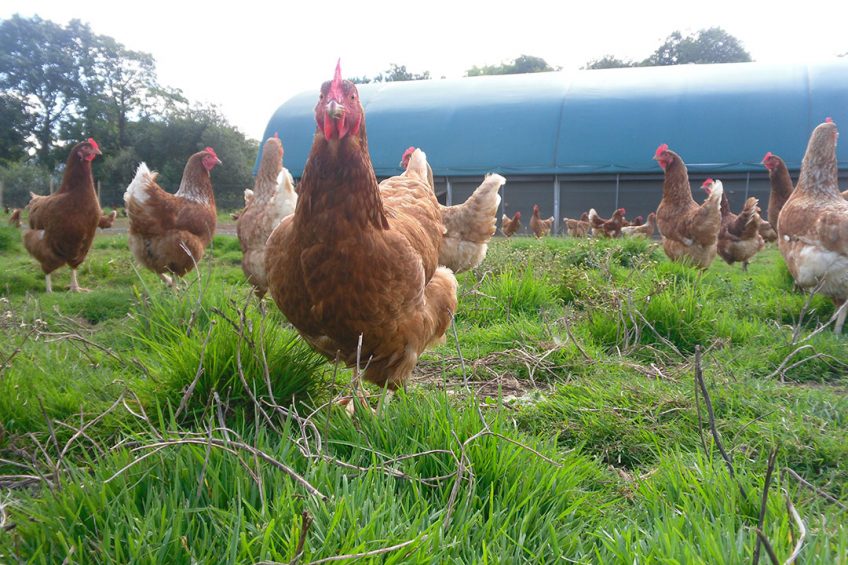Gaining a premium through organic conversion

With the free-range egg market well supplied, could now be the time to take the next step and convert to organic farming? Soil Association Certification’s trade consultant Finn Cottle outlines the organic market’s potential while senior certification officer Tommy Copestake sets out the production standards and conversion process.
The organic egg sector is a buoyant part of the market and at a growth rate of more than 10% year-on-year, it is outperforming non-organic egg production, according to trade consultant Finn Cottle.
Ms Cottle estimates that the sector could already be worth more than £90m and availability on-shelf is improving with more organic lines launching.
“People seem to understand that organic eggs are much higher welfare and are therefore willing to pay a little more to give hens a truly free-range life,” Ms Cottle says.
“As well as being an excellent opportunity for businesses and providing clear benefits to the hens, organic systems also provide significant environmental benefits with wildlife 50% more abundant on organic farms,” she adds.
Any farm can convert to Soil Association certified organic egg production in less than a year, however the organisation’s standards are rigorous and go beyond the minimum legal standards set out in the EU Organic Regulations, says Tommy Copestake.
First steps and inspection process
Starting the journey to converting to organic farming can be a simple process, typically taking a few months. The first step towards converting to organic farming is to contact approved certifying bodies, a list of which can be found on DEFRA’s website.
Soil Association Certification is one of these bodies, and as a wholly owned subsidiary of the Soil Association charity, inspects its organic licensees according to standards set by the charity.
It is the largest organic certifier in the UK, and will initially send out an information pack that includes application forms. Once the forms are returned, an inspection will be arranged, normally within 2 months of the application forms being received, explains Mr Copestake.
Depending on how the unit and land are managed currently, there may be some requirements to bring it up to organic standards, which the certification team will support with.
A list of application requirements will then be set out and these depend on the state of the unit and the level of additional procedures to bring it up to the standard that is likely to be approved – it is important to note that the land must be certified organic before the livestock farmed on it.
Approval is usually granted shortly after the work is done and a certificate, along with an organic trading schedule, will be issued.
Field records will be checked at the initial inspection, for example to check for prohibited inputs that may have been used on ranges. For poultry there is usually a conversion period of one year, but this may be reduced to 6 months if ranges have been free from those prohibited inputs for the previous year.
Follow-up inspections, to ensure the unit continues to meet the standards and has a health plan in place, are made annually. These can be carried out in conjunction with Red Tractor and supermarket assurance schemes to keep time taken to a minimum. A further 10% are made on a risk basis, for example, if a farm is having difficulties with compliance. In addition EU law requires 10% of all assessments to be carried out as unannounced spot-checks.

Financial benefits
With the application complete, poultry farms can begin selling organic eggs after a 6-month conversion period – far less time than the 2 years required for arable farms, and farmers can begin to enjoy the premium price that organic eggs command. Further financial incentive comes in the form of environmental support payments. Organic Entry Level Scheme producers receive £70/ha for the first 2 years and £40/ha for the remainder of the five-year agreement. The higher initial payment recognises the additional costs and potentially smaller premiums while farms are going through the conversion period.
Birds, flock size and stocking rate
Unlike the organic broiler sector, which demands slower growing breeds, layer flocks can use any hens that are suited for outdoor production. However, the flock size is restricted to a maximum of just 2,000 birds under Soil Association standards and a stocking rate of 1,000 birds per hectare. A stipulation to rest paddocks for nine months between flocks means that the actual stocking rate is lower still, explains Mr Copestake. But there is no need to buy in a new flock and conversion can be made while the birds are in lay.
However, the flock must be farmed to Soil Association standards for a six-week conversion period before eggs can be marketed as organic.
Range requirements and management
Only approved forms of fertiliser can be applied within the organic system. The aim with the range is to encourage birds to roam widely away from the house. That means establishing and maintaining dense swards with suitable cover and enrichment across the range.
This can be achieved through tree planting, positioning trailers or pallets, bales and netting. Access to the range must be provided continuously during daylight hours once the birds are 12 weeks old. Because the stocking rate stipulated is relatively low, there are usually fewer problems with poaching and worm burdens. However, where problems arise the Soil Association will provide guidance on rectifying issues and any treatments that are permissible.
Building space requirements
Both mobile and static housing types are acceptable but must allow sufficient space to house birds at 6/sq metre and provide 4m of pop-holes. Soil Association flooring requirements go beyond EU stipulations (1/3 solid to 1/3 slatted) and insist on 50% of the total floor area being solid with a dry, friable litter maintained at all times. A- or H- frame perches must also be installed or extended to give 18cm of space per bird.
Water lines, drinkers and feed equipment do not count towards the total perch space. “Birds must have adequate space to express normal behaviour such as scratching and foraging around the floor area with some form of enrichment like straw bales to pull at.” There should also be a minimum of eight hours without artificial lighting to give the birds chance to roost.
Health and welfare problems
Bird health and freedom to express natural behaviour underpin the organic free range system, so flock managers are asked to produce a welfare outcome assessment. Beak trimming is not permitted on organic units but the extra space and enriched environment helps to reduce feather pecking, says Mr Copestake. But if problems arise, the Soil Association will assign a welfare officer to provide ongoing support alongside the flock manager to ensure the problem is overcome. Similarly with disease outbreaks the organisation will work to support farms. The use of antibiotics to treat disease is permitted where required on a case-by-case basis but routine administration is prohibited. When antibiotic use is needed for the health and welfare of the flock a strict and extended withdrawal period that is twice the recommended period must be observed and documented. There are also controls on which products can be used to tackle pests such as red mite and the active ingredients used in disinfectants.
Feed
There is a strict ban on feeding any GM ingredients and only organic feed can be offered which has been produced on certified farms and processed in approved mills. But, in recognition of the difficulties attached to sourcing certain proteins, non-organic ingredients can form up to 5% of the feed. Feed costs are likely to be higher because of the extra space.
Purton House Organic, WiltshireDemand for organic free range eggs is growing fast as customers look for even greater food assurance, according to Wiltshire-based flock owner Rowie Meers. The Purton House Farm site runs 2,000 layers split into 2 main flocks of 600 birds each and a further 4 smaller flocks. Egg productionEgg production is typically 75-85% of non-organic layers with rates falling to about 60% by depopulation. Purton House sells most of its eggs through the growing online business Farm Drop which operates in a number of UK cities and guarantees to give the farmer at least 70% of the sale price. Other outlets include local customers through a doorstep delivery or the farm’s own shop. Retail prices are up to £4 for a dozen with eggs sold wholesale for about £3.20/doz. Feed costsHowever, while the returns are good, feed costs can be extremely high. “As a small farm we lack the scale to buy in large bulk so our feed costs are high at £420-£430/tonne,” says Mrs Meers. “This can make the conversion period a strain particularly as the organically reared pullets are more expensive to buy-in at £8.95 each,” she adds Range managementThe 7ha range area provides well over the Soil Association’s 1,000 birds/ha standard and complies with requirements for cover. “The range area was planted with trees more than 10 years ago and provides a lot of wooded cover making it ideal for the birds,” says Mrs Meers. But the range presents one of the main difficulties associated with organic farming – weed control, she says. Weed burdens can be significant and although it is not in the spirit of organic farming a lot of farms tackle weeds before entering the conversion period. Once under the organic farming scheme paddocks must either be weeded mechanically or by hand. Flock health“Routine antibiotic use is banned and any treatment of sick birds is subject to withdrawal periods which are twice or sometimes three times the statutory periods recommended,” says Mrs Meers. However, lighter stocking rates means disease challenges and worm burdens are low so the farm has not needed to treat hens for parasites. “If we did have a breakdown, hen welfare would come first so we would apply for a derogation to treat birds with Soil Association approved products,” says Mrs Meers. Likewise any chemical use, such as disinfectant at turnaround and control of red mite in the farm’s Haygrove tunnels, must first be approved. Again, the low stocking densities in the houses means red mite is not an issue, she reports. Feather pecking also does not occur, despite organic scheme rules preventing any beak trimming. The extras space allowance inside the house and outdoors allows the birds to express natural behavioural patterns which means they don’t get as bored. It also means any weaker birds can find a place to get away from dominant hens. |
Join 31,000+ subscribers
Subscribe to our newsletter to stay updated about all the need-to-know content in the poultry sector, three times a week. Beheer
Beheer








 WP Admin
WP Admin  Bewerk bericht
Bewerk bericht